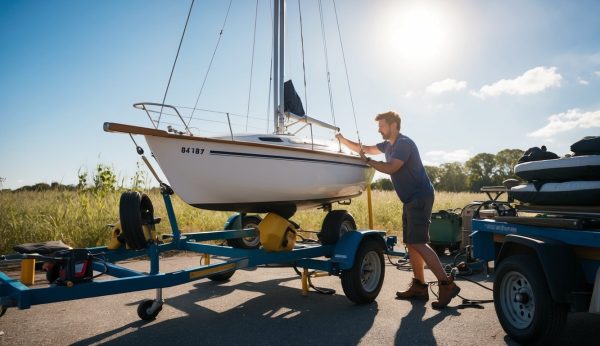As a sailboat owner, transporting your boat can seem like a daunting task, with numerous risks involved, such as damage during transit and weather conditions. However, with the right preparation and partner, boat transport can be done safely and with peace of mind. Here’s a guide to help you transport your sailboat safely and efficiently.
Prepare Your Sailboat
Before wondering how to safely transport a sailboat, it’s important to take precautions to prevent any damage during transit. Properly protect the mast and rigging with padded sleeves to prevent scratches or dents. Remove any loose items and sails that might shift during transport. This will help ensure your sailboat arrives in the same condition in which it left.
Find the Right Boat Transporter
Finding the right boat transporter is crucial for safely transporting your sailboat. Look for a boat transport company with experience transporting sailboats and positive reviews from past clients. CitizenShipper is a transportation marketplace that connects people with professional, insured, and background-checked transporters specializing in boat transport. Their network of experienced boat transporters will ensure that your sailboat is transported safely and securely.
Choose the Right Type of Transport
Two main options are overland or sea transport. Overland transport, such as trucking or rail, is usually less expensive and faster than sea transport, which is typically used for larger boats. Consider your sailboat’s size and destination when choosing the right type of transport.
Check Insurance
Insurance is a critical aspect of boat transport. Check your insurance policy to see if it covers transport. Many boat insurance policies cover transportation, but confirming this with your insurance provider beforehand is important. Additionally, all reputable boat transport companies are required to have insurance to cover any damages or losses that might occur during transport.
Prepare for weather conditions. Be prepared for weather conditions during transit. If transporting your sailboat during winter, make sure to winterize your sailboat before transport to protect it from the cold. If transporting during hurricane season, be prepared for delays or cancellations in the event of a storm.
When considering ways to safely transport a sailboat, there are different methods, such as single-axle trailers, multi-axle trailers, cargo ships, and trains. They can also be transported across oceans by hiring a captain and crew. The costs of transport vary depending on the size and type of boat; check out the best prices by CitizenShipper.
Transporting a sailboat requires careful planning and attention to detail. You are responsible for maintaining the trailer and driving safely as the owner. International logistics also need to be organized to ensure a smooth process. In this article, we will discuss how to simplify the transportation process.
How to Safely Transport a Sailboat
Cost to Transport a Sailboat
The cost of sailboat transport can vary greatly depending on the size of the boat. Small sailboat transportation is cheaper.
Transporting a sailboat can be accomplished through various methods, and finding the most cost-effective approach may not be immediately apparent. Depending on the boat, it may be more economically viable to use a specially-crafted yacht transport vessel or to enlist a delivery crew. Thoroughly researching all available options and soliciting multiple quotes can result in substantial savings in transportation, delivery, and insurance expenses incurred in safeguarding your vessel against harm.
The ideal method of transport for a sailboat depends on its size and dry weight. The following are the prevailing means of transporting sailboats over both brief and lengthy distances:
Trailering
Some sailboats can be towed by typical cars, provided you have a heavy-duty tow hitch installed. Larger sailboats usually need to be towed by a pickup truck or SUV.
Pickup trucks that run on gasoline and have a weight capacity of half a ton can be effective for lighter sailboats as long as the dry weight of the vessel does not surpass the vehicle’s towing capability.
The sailboat’s mast, boom, and standing rigging should be secured regardless of its size, and you may need to collapse or remove them.
The majority of trailer sailers can be transported by single-rear-wheel trucks with a weight capacity of half-ton or 3/4-ton. However, bigger sailboats may necessitate a multi-axle trailer and a gooseneck, a configuration frequently observed with 3/4-ton or 1-ton trucks with dual rear wheels.
Rules for Towing in the United States
The rules of the road for towing are clear. With a standard driver’s license, the maximum overall trailer length you can tow is 60 feet, and the maximum length of a trailer surface is 53 feet.
A class C trailer has a maximum width of 8 feet and 6 inches, taking into account any articles attached to the trailer. The regulations mean that your boat’s beam cannot exceed about 8 feet.
Holders of a Commercial Driver’s License (CDL) are eligible to tow significantly larger trailers and operate semi-trucks. This makes it possible to transport some larger sailboats with greater beam width via this method, provided they remain within the maximum height limit.
The height criteria for trailers fluctuate between 13 feet and 6 inches to 14 feet, contingent upon the area. The measurement is taken from the ground to the highest point of the object on the trailer.
If you are towing a boat with a full keel, it is essential to plan your route carefully, as some older overpasses and railroad bridges are shorter than 13 feet.
In general, it is advisable to entrust the transportation of larger sailboats to skilled towing professionals. Accomplished drivers with ample experience in operating massive rigs and holding commercial licenses can safely transport quite substantial vessels, albeit at a cost. The primary benefit of engaging the services of a professional provider is the transfer of risk from your hands to theirs, thereby ensuring peace of mind.
FAQs: Safely Transport a Sailboat
What is the most cost-effective method of transporting a sailboat?
The most cost-effective method of transporting a sailboat depends on the size and type of the boat, as well as the distance of transport. Researching all available methods and requesting multiple quotes can help you find the most economical option.
Can I tow my sailboat with my car?
Some smaller sailboats can be towed by typical cars, provided you have a heavy-duty tow hitch installed. Larger sailboats usually require a pickup truck or SUV for towing. It is recommended to hire a professional.
Do I need a special license to tow a sailboat?
You can tow a sailboat up to a certain length and weight with a standard driver’s license. However, larger sailboats may require a commercial driver’s license (CDL) to tow.
What should I do to prepare my sailboat for transport?
The sailboat’s mast, boom, and standing rigging should be secured regardless of its size, and you may need to collapse or remove them. Additionally, it is important to check the boat’s weight and dimensions to ensure it can be safely transported.
Should I hire a professional service to transport my sailboat?
Hiring a professional service for larger sailboats is recommended to ensure safety and avoid damage during transport. Experienced drivers with commercial licenses can transport larger vessels safely but at a cost.
How can I ensure the safety of my sailboat during transport?
Prioritizing safety is crucial during sailboat transport. This includes securing the mast, boom and standing rigging and following towing rules and regulations. Hiring a professional service can also provide peace of mind and reduce the risk of damage.
Bottom Line: Transport a Sailboat
By following these tips, you can ensure that your sailboat is transported safely and with peace of mind. Properly prepare your sailboat for transport, choose the right boat transporter, consider the right type of transport, check insurance coverage, and be prepared for weather conditions during transit. With these precautions taken, you can rest easy knowing your sailboat is in good hands.




